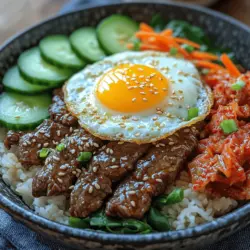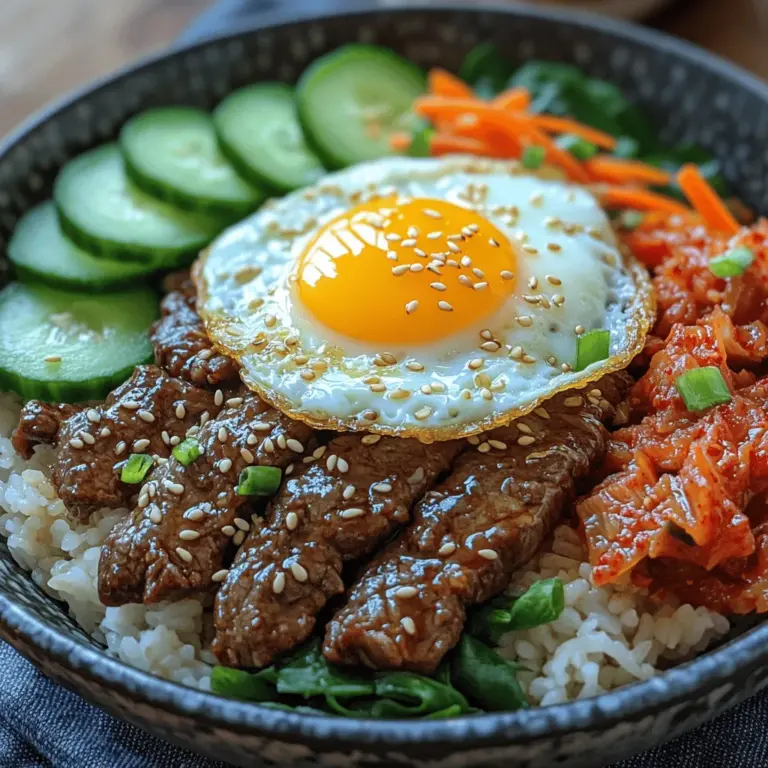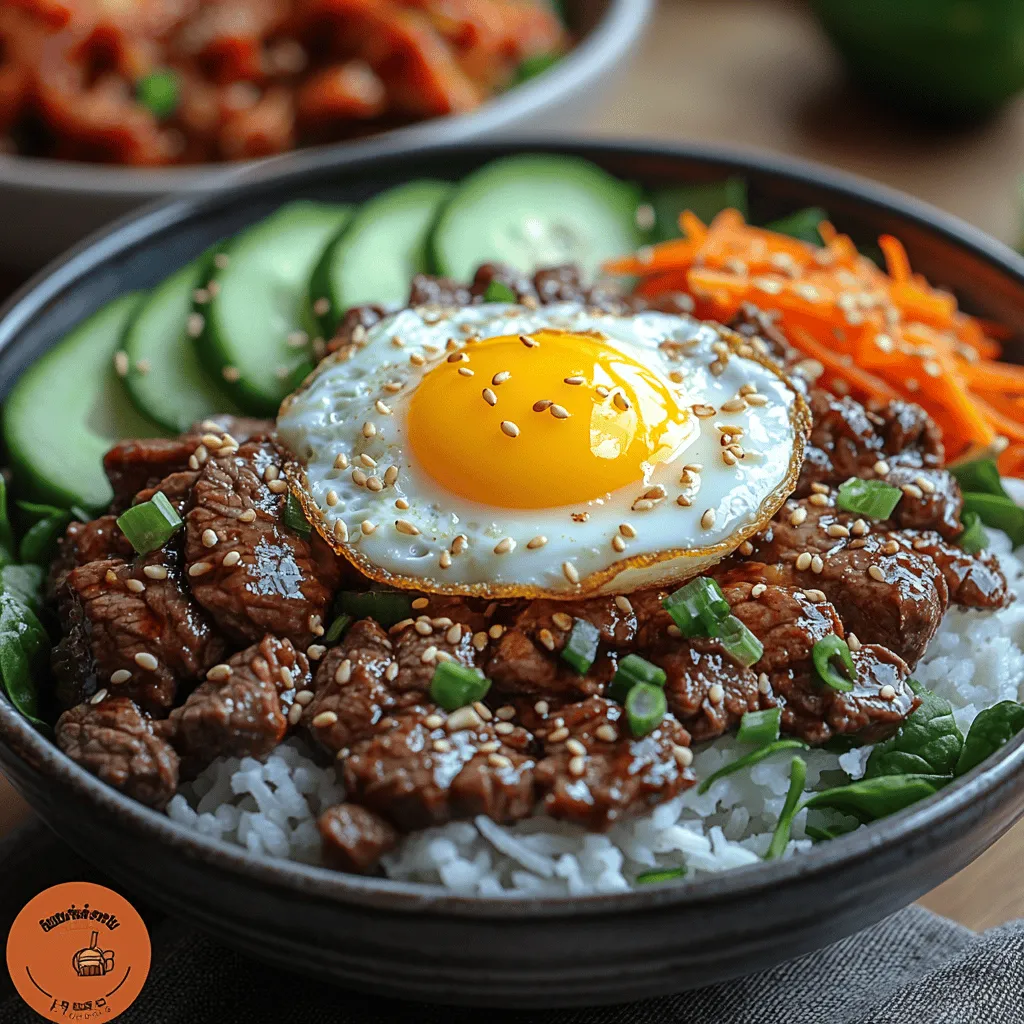Introduction
Korean cuisine has gained remarkable popularity around the globe, celebrated not just for its vibrant flavors but also for its health benefits and cultural significance. Dishes like kimchi, bibimbap, and, of course, bulgogi, have captured the hearts and taste buds of food enthusiasts everywhere. Among these, Beef Bulgogi stands out as a beloved classic, embodying the essence of Korean cooking with its tender marinated beef and savory-sweet flavors.
Beef Bulgogi, which translates to “fire meat,” has deep roots in Korean history, dating back to the Goguryeo era (37 BC – 668 AD). Traditionally, this dish was grilled over an open flame, imparting a unique smoky flavor. Today, it is often stir-fried or cooked on a grill, making it accessible and enjoyable for home cooks. The appeal of Beef Bulgogi Bowls lies not only in their delicious taste but also in their versatility. They allow for customization with various toppings and sides, making them a perfect meal for families, gatherings, or meal prep enthusiasts.
In this article, we will explore the rich history and flavors of Beef Bulgogi, break down the key ingredients for creating a delightful bowl, and guide you through the initial steps of preparing this beloved dish.
Understanding Beef Bulgogi
Definition and History of Bulgogi
Bulgogi is a traditional Korean dish made from thinly sliced beef marinated in a savory-sweet sauce, which is then grilled or stir-fried. The marinade typically consists of soy sauce, sugar, sesame oil, garlic, and pepper, creating a harmonious blend that enhances the natural flavors of the beef. The dish’s history is fascinating; it is believed to have originated in ancient Korea, initially enjoyed by the royal families before becoming a staple in Korean households.
As Korea underwent various cultural influences over the centuries, bulgogi evolved, incorporating different ingredients and cooking techniques. This adaptability is one reason why it remains a beloved dish today, reflecting the diverse culinary landscape of Korea.
Key Flavor Components That Make Bulgogi Unique
The magic of Beef Bulgogi lies in its marinade, which is a perfect balance of sweet and savory. The soy sauce provides umami, while brown sugar or honey adds sweetness, creating a delightful contrast. Sesame oil imparts a nutty aroma, and minced garlic and ginger add depth and warmth. Ground black pepper and gochugaru (Korean red pepper flakes) can also be included for an extra kick, making the flavor profile even more complex.
Another crucial aspect of bulgogi is the cut of beef used. Tender cuts such as sirloin or ribeye are preferred, as they absorb the marinade beautifully and remain juicy when cooked. The combination of high-quality beef with a well-crafted marinade is what elevates bulgogi from a simple meal to a culinary experience.
Variations of Bulgogi Across Different Regions in Korea
While bulgogi is universally loved, regional variations exist that reflect local tastes and ingredients. For instance, in Jeolla Province, a sweeter version of bulgogi is made with additional fruits like pear or apple in the marinade. In contrast, the Gangwon Province adds a touch of spiciness with gochujang (Korean chili paste). These regional adaptations highlight how bulgogi can be tailored to suit different palates while staying true to its essence.
Ingredients Breakdown
Overview of the Main Ingredients Used in the Recipe
Creating the perfect Beef Bulgogi Bowl starts with understanding the essential ingredients. Here’s what you will need:
– Beef: The star of the dish. Sirloin or ribeye is recommended for its tenderness.
– Marinade: A delightful concoction of soy sauce, sugar, sesame oil, minced garlic, and optionally, fresh ginger and gochugaru.
– Rice: A base for your bowl, jasmine or brown rice works well.
– Vegetables: Common choices include carrots, bell peppers, and green onions, which add freshness and crunch.
– Toppings: Optional garnishes like sesame seeds or nori can elevate the dish.
The Importance of Each Ingredient in the Marinade
Every ingredient in the bulgogi marinade plays a pivotal role in achieving the iconic flavor. Soy sauce serves as the foundation, providing saltiness and depth. Sugar balances the saltiness and aids in caramelization during cooking, giving the beef a beautiful glaze. Sesame oil contributes aroma and richness, while garlic and ginger enhance the overall flavor with their aromatic qualities. The addition of black pepper or gochugaru introduces a delightful kick that can be adjusted to your taste.
Detailed Description of Rice Options
When it comes to rice, the choice can significantly impact the overall taste of your Beef Bulgogi Bowl. Jasmine rice is a popular option due to its fragrant aroma and slightly sticky texture, making it perfect for holding the bulgogi and toppings together. On the other hand, brown rice offers a nuttier flavor and is higher in fiber, making it a healthier choice. Both options provide a sturdy base for the marinated beef and vegetables, but your preference will depend on dietary needs and personal taste.
Discussion on the Health Benefits of Vegetables Used in the Bowl
Incorporating a variety of vegetables into your Beef Bulgogi Bowl not only enhances the dish’s flavors but also adds vital nutrients. Carrots are rich in beta-carotene, supporting eye health, while bell peppers provide a boost of vitamin C and antioxidants. Green onions add a touch of freshness and are a good source of vitamins K and A. By adding these colorful veggies, you create a more balanced meal, making it both delicious and nutritious.
Preparing the Beef Marinade
Step-by-Step Guide on How to Create the Perfect Marinade
Creating the perfect marinade is essential for a flavorful bulgogi. Follow these steps:
1. Gather Ingredients: Start with the following ratios for a standard marinade:
– 1/4 cup soy sauce
– 2 tablespoons brown sugar or honey
– 1 tablespoon sesame oil
– 3 cloves garlic, minced
– 1 teaspoon grated ginger (optional)
– 1/2 teaspoon ground black pepper or gochugaru (optional)
2. Mix: In a medium bowl, combine the soy sauce, sugar, and sesame oil. Whisk until the sugar is dissolved.
3. Add Aromatics: Stir in the minced garlic and ginger, followed by the black pepper or gochugaru if you prefer some heat.
4. Taste: Adjust the sweetness or saltiness to your liking. The marinade should be a perfect balance of flavors.
5. Marinate the Beef: Place your thinly sliced beef in a zip-top bag or a shallow dish, pour the marinade over the meat, and ensure it is fully coated. Seal the bag or cover the dish and refrigerate for at least 30 minutes, allowing the flavors to meld.
Tips for Choosing the Right Cut of Beef
When it comes to bulgogi, the cut of beef you choose is crucial. Sirloin is a popular choice due to its balance of tenderness and flavor. Ribeye, with its marbling, provides an even richer taste but can be pricier. Whichever cut you choose, ensure the beef is sliced thinly against the grain. This technique not only helps with tenderness but also allows the marinade to penetrate the meat effectively.
Importance of Marinating Time and How It Affects Flavor
Marinating time can significantly influence the overall flavor of your bulgogi. While 30 minutes is the minimum recommended time, marinating for 2 to 4 hours—or even overnight—can yield even better results. This extended time allows the marinade to fully penetrate the meat, resulting in more intense flavors and tenderness. However, avoid marinating for too long, as the enzymes in the marinade can break down the meat too much, leading to a mushy texture.
Cooking the Rice
The Method for Cooking Jasmine Rice to Achieve the Perfect Texture
Cooking perfect jasmine rice is a straightforward process that requires attention to detail. Here’s how to do it:
1. Rinse the Rice: Start by measuring 1 cup of jasmine rice and rinsing it under cold water until the water runs clear. This step removes excess starch and prevents the rice from becoming gummy.
2. Cook the Rice: In a medium saucepan, combine the rinsed rice with 1 1/2 cups of water. Add a pinch of salt if desired. Bring the mixture to a boil over medium-high heat.
3. Simmer: Once boiling, reduce the heat to low, cover the pot with a lid, and let it simmer for about 15 minutes. Avoid lifting the lid during this time, as this can disrupt the cooking process.
4. Rest: After 15 minutes, remove the pot from heat and let it sit, covered, for an additional 10 minutes. This resting period allows the rice to steam and finish cooking.
5. Fluff: Finally, use a fork to fluff the rice gently before serving. This will separate the grains and enhance the texture.
Comparison of Jasmine Rice and Brown Rice
While jasmine rice is fragrant and slightly sticky, brown rice is a whole grain with a firmer texture and nuttier flavor. Nutritionally, brown rice is higher in fiber, which can aid digestion and promote satiety. However, jasmine rice cooks faster and has a more delicate taste that pairs beautifully with the bold flavors of bulgogi. The choice between the two ultimately depends on your dietary preferences and desired flavor profile.
Suggestions for Making Rice Ahead of Time for Meal Prep
If you’re looking to streamline your cooking process, preparing rice in advance is a great strategy. Cook a larger batch of rice and store it in an airtight container in the refrigerator for up to 4 days. When ready to serve, simply reheat the rice in the microwave or on the stovetop, adding a splash of water to restore moisture. This not only saves time during busy weeknights but also allows you to enjoy delicious Beef Bulgogi Bowls whenever the craving strikes.
By understanding the history and significance of Beef Bulgogi, as well as mastering the essential components of the dish, you are well on your way to creating a delightful meal that is both satisfying and flavorful. Stay tuned for the next part, where we will delve deeper into the cooking process and assembly of the Beef Bulgogi Bowls!
Cooking the Beef
Cooking the beef for your Korean Beef Bulgogi is a critical step that influences the overall flavor and texture of the dish. You have two main options for cooking your marinated beef: using a skillet or a grill pan.
Skillet vs. Grill Pan: Both methods yield delicious results, but they come with different advantages. A skillet is great for convenience and ease of cleanup, while a grill pan can impart a lovely char and smokiness to the beef. If you’re aiming for that authentic Korean BBQ flavor, the grill pan might be your best bet, as it allows for better heat distribution and the creation of grill marks that enhance presentation.
Achieving a Nice Sear: To achieve a perfect sear on the beef, ensure that your pan is preheated adequately before adding the marinated meat. A hot cooking surface will help to caramelize the sugars in the marinade, resulting in a rich, flavorful crust. Do not overcrowd the pan; cook the beef in batches if necessary to maintain high heat. This will help you avoid steaming the meat, which can lead to a rubbery texture.
Knowing When the Beef is Perfectly Cooked: The key to perfectly cooked bulgogi lies in its doneness. For beef, a medium-rare cook, which is around 130°F (54°C), is often ideal, as it allows the meat to remain tender and flavorful. You can use a meat thermometer to ensure accuracy or rely on visual cues; the beef should be browned on the outside with a hint of pink in the center. Remember that the beef will continue to cook slightly after being removed from the heat, so consider taking it off just before it reaches your desired doneness.
Creating the Perfect Bowl
Once your beef is cooked, it’s time to assemble your Beef Bulgogi Bowl. This is where you can showcase your culinary creativity and attention to detail.
Step-by-Step Assembly: Start with a base of steamed rice—white or brown will work beautifully. Spoon a generous amount of cooked bulgogi over the rice, allowing the flavorful juices to soak into the grains. Next, add a colorful array of toppings: sliced cucumber, shredded carrots, and vibrant radishes. You can also include sautéed spinach or other seasonal vegetables to enhance the health aspect of your bowl.
Importance of Presentation: Presentation plays a crucial role in dining experiences. A bowl filled with various colors and textures not only pleases the eye but also signals a well-rounded meal. Aim for a balance of colors: the deep brown of the bulgogi, the bright orange of the carrots, and the fresh green of the cucumbers create a visually appealing dish.
Optional Ingredients: To elevate your bowl further, consider adding a fried egg on top and a side of kimchi. The runny yolk adds creaminess, while the spicy and tangy kimchi offers a delightful contrast to the sweetness of the bulgogi. Both ingredients will enhance the flavor profile of your bowl and provide additional nutritional benefits.
Garnishing the Bowl
Garnishes can make a significant difference in the final presentation and taste of your dish.
Suggestions for Garnish: A sprinkle of sesame seeds not only enhances the visual appeal but also adds a nutty flavor that complements the bulgogi beautifully. Additionally, finely sliced green onions can add a fresh, crisp element to the dish. Both garnishes are traditional in Korean cuisine and help to tie the components of the dish together.
How Garnishes Elevate the Dish: Beyond aesthetics, garnishes can enhance the flavor complexity of your dish. The crunch of sesame seeds and the sharpness of green onions create layers of texture and taste, making each bite of your Beef Bulgogi Bowl exciting.
Nutritional Information
Understanding the nutritional content of your Beef Bulgogi Bowl can help you appreciate its health benefits.
Caloric Breakdown: On average, a serving of Beef Bulgogi Bowl contains approximately 500-600 calories. This can vary based on portion sizes and the specific ingredients you choose, such as the type of rice or additional toppings.
Health Benefits: The main ingredients in this dish provide a range of health benefits. For example, beef is a great source of high-quality protein, iron, and B vitamins, which are essential for energy production. The vegetables in your bowl offer fiber, vitamins, and antioxidants, contributing to a well-balanced meal.
Discussion of Macronutrient Balance: A typical Beef Bulgogi Bowl offers a good balance of macronutrients. The protein from the beef supports muscle repair and maintenance, while the carbohydrates from the rice provide energy. The inclusion of vegetables ensures a healthy intake of fiber and micronutrients, making this dish both satisfying and nutritious.
Cultural Significance of Serving Bulgogi
Bulgogi holds a special place in Korean culture, often associated with social gatherings and communal meals.
Tradition of Sharing Meals: In Korean culture, meals are typically enjoyed together, fostering a sense of community and togetherness. Bulgogi is often served at family gatherings, celebrations, and special occasions, symbolizing hospitality and warmth.
Special Occasions and Gatherings: Often, Bulgogi is prepared during significant events such as birthdays, holidays, and even weddings. Its rich flavor and tender texture make it a crowd-pleaser, ensuring that it remains a staple in Korean cuisine.
Customizing the Dish: One of the beauties of the Beef Bulgogi Bowl is its versatility. You can customize it based on personal or family preferences—substituting beef with chicken or tofu for a vegetarian option, or adjusting the spice levels to suit your taste. This adaptability makes it an excellent choice for various occasions and dietary needs.
Conclusion
Beef Bulgogi Bowls are not only a delicious meal but also a wonderful way to explore the rich flavors of Korean cuisine. With tender marinated beef, vibrant vegetables, and carefully selected garnishes, this dish offers a perfect balance of taste and nutrition.
I encourage you to try making this dish at home to experience the joy of cooking and sharing food with loved ones. The process of creating a Beef Bulgogi Bowl allows you to delve into the nuanced flavors of Korean cooking while enjoying the simple pleasure of a home-cooked meal. Embrace the experience, and let the flavors transport you to the heart of Korea with each delightful bite.



